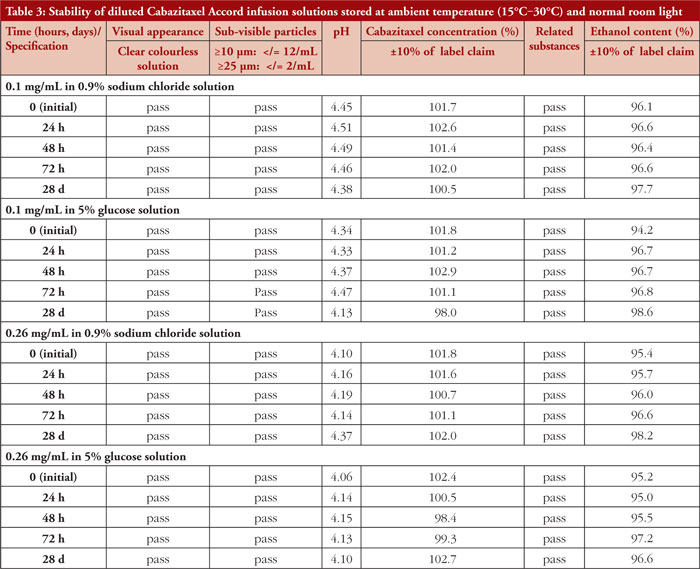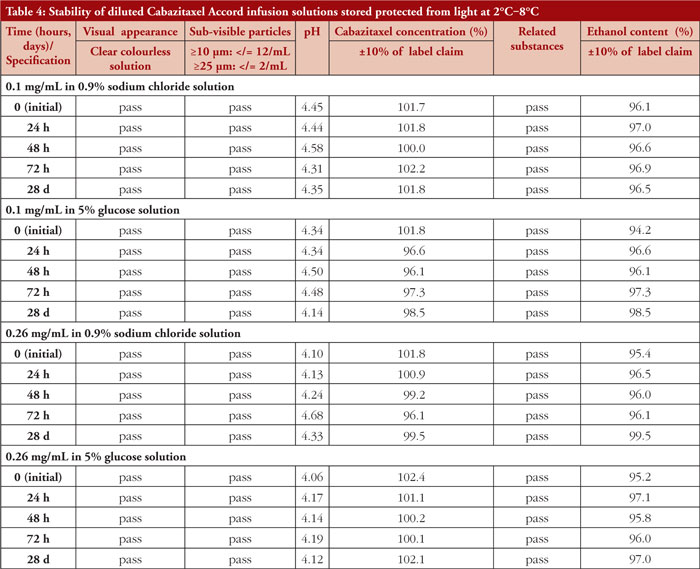Physicochemical stability of Cabazitaxel Accord in punctured original vials and after dilution with 0.9% sodium chloride or 5% glucose solution in non-PVC bottles
Published on 2024/09/11
Generics and Biosimilars Initiative Journal (GaBI Journal). 2024;13(2):114-17.
Author byline as per print journal: Irene Krämer, PhD; Frank Erdnuess, PhD; Judith Thiesen, PhD
|
Study objectives: To determine the physicochemical stability of undiluted Cabazitaxel Accord in punctured original vials and after dilution with 0.9% sodium chloride solution or 5% glucose solution in non-PVC bottles at the concentrations 0.1 mg/mL and 0.26 mg/mL. |
Submitted: 29 February 2024; Revised: 15 April 2024; Accepted: 26 April 2024; Published online first: 6 May 2024
Introduction
Cabazitaxel is a novel, semisynthetic taxane derivative. Its antineoplastic efficacy is based on induction of polymerization of tubulin monomers and simultaneously the inhibition of depolymerization, leading to mitotic cell cycle arrest and ultimately cell death. It is approved in combination with prednisone or prednisolone for the treatment of metastatic castration resistant prostate cancer previously treated with a docetaxel-containing regimen [1]. Since cabazitaxel is poorly soluble in water, licensed medicinal products contain polysorbate 80 and ethanol anhydrous as excipients to solubilise the active drug substance [1]. Prior to administration, Cabazitaxel Accord 20 mg/mL must be diluted with 0.9% sodium chloride or 5% glucose infusion solution in PVC-free containers to a concentration between 0.1 mg/mL and 0.26 mg/mL.
According to the Summary of Product Characteristics (SmPC), in-use stability after dilution is provided for 8 hours at ambient temperature (15°C– 30°C) and for 48 hours under refrigeration. Any unused portion in the punctured vial must be discarded [1]. Stability data are published for other cabazitaxel-containing medicinal products. Cabazitaxel 20 mg/mL concentrate was proven to be physicochemically stable for 28 days after first opening [2]. Diluted cabazitaxel infusion solutions in the concentration range of 0.1 mg/mL to 0.26 mg/mL were found to be physicochemically stable for up to 28 days, regardless of the storage temperature [2–4].
Study objectives
The aim of this study was to determine the physicochemical stability of Cabazitaxel Accord 20 mg/mL concentrate after first opening, as well as the stability of diluted infusion solutions of 0.1 mg/mL and 0.26 mg/mL. These solutions were stored in non-PVC bottles pre-filled with either 0.9% sodium chloride or 5% glucose solution under various storage conditions for a maximum period of 56 days.
Methods
A total of five different cabazitaxel test solutions were prepared using the European Medicines Agency’s (EMA) licensed Cabazitaxel Accord 20 mg/mL (batch number M2017810). Punctured vials were stored under normal room light conditions at 20°C–25°C for 56 days. Diluted test solutions were stored for 28 days, either light-protected under refrigeration (2°C–8°C) or at ambient temperature (15°C–30°C) and normal room light. Samples were taken and analysed initially (Day 0) and at predetermined time points. For detailed information, refer to Table 1.
The physical stability of test solutions was assessed by pH measurements and visual inspection for any changes in colour, clarity, and the presence of particulate matter, as well as the measurement of sub-visible particle numbers.
The chemical stability of test solutions was assessed via high-performance liquid chromatography (HPLC) analysis [5]. Acceptance criteria were set to a concentration of 95%– 105% of the label claim for cabazitaxel concentrate and initial ±10% for diluted test solutions [5]. In parallel, the type and quantity of related compounds were analysed by HPLC. For undiluted Cabazitaxel Accord solutions, acceptance criteria for peaks of related compounds were set as follows:
- Impurity A, B, C, D, E, F,G, H: </= 0.4%
- Maximum single unknown impurity: </= 0.2%
- Total impurities: </= 3.0%
Ethanol content of undiluted and diluted test solutions was determined (acceptance criteria : ethanol content 95%–105 % of label claim for cabazitaxel concentrate, initial ±10% for diluted test solutions).
In punctured vials the water content was determined by Karl Fisher titration (acceptance criteria: </= 3.0% w/w).
Results
Cabazitaxel Accord 20 mg/mL concentrate in punctured vials remained physicochemically stable when stored at 20°C –25°C without light protection for 56 days. Neither colour changes, turbidity, nor visible particles were observed during visual inspection. Sub-visible particle numbers also fulfilled the acceptance criteria. The HPLC assays revealed only slight variations of cabazitaxel concentrations during the observation period, which were related to the assay variability (compare Table 2). In the corresponding chromatograms, peaks related to impurities B, C, H, and an unknown impurity were detected. Peaks of individual impurities amounted to a maximum of 0.096%, and total impurities amounted to a maximum of 0.255% of the main peak, thereby fulfilling the acceptance criteria. At each sampling time point, ethanol (nearly 100%) and water content (about 1%) remained within the acceptance limits.
Diluted Cabazitaxel Accord infusion solutions were shown to be physicochemically stable over the observation period of 28 days, regardless of concentration (0.1 mg/mL, 0.26 mg/mL), type of vehicle solution (0.9% sodium chloride or 5% glucose solution), and storage temperature chosen, see Tables 3 and 4. In the HPLC chromatograms of diluted test solutions, only a small peak of impurity B was detected. Additionally, in the chromatograms of the 0.26 mg/mL solutions, a peak of an unknown impurity became evident. No peaks of other impurities were detected.
The results of this physicochemical stability study of Cabazitaxel Accord are in accordance with the results of previously published studies. Undiluted and diluted cabazitaxel solutions from various brand products were found to be physicochemically stable over the 28-day observation period [2–4].
Conclusion
Cabazitaxel Accord solution concentrate at 20 mg/mL was physicochemically stable for 56 days after first opening. After dilution with 0.9% sodium chloride or 5% glucose infusion solution to concentrations of 0.1 mg/mL and 0.26 mg/mL cabazitaxel, test solutions remained physicochemically stable for 28 days, regardless of storage temperature.
Thus, residues of Cabazitaxel Accord 20 mg/mL in punctured original vials can be used for up to 56 days when stored at room temperature. Additionally, diluted Cabazitaxel Accord infusion solutions ranging from 0.1 mg/mL to 0.26 mg/mL in non-PVC bottles may be prepared in advance and used over a period of 28 days, regardless of the type of vehicle solution and storage temperature.
Analysis was performed and documented by an accredited external laboratory. Results were carefully checked for plausibility and cautiously interpreted.
Funding sources
This study was funded by Accord Healthcare.
Competing interests: The authors Irene Krämer, Frank Erdnuess, and Judith Thiesen have no competing interest s to declare.
Provenance and peer review: Not commissioned; externally peer reviewed.
Authors
Professor Irene Krämer, PhD
Frank Erdnuess, PhD
Judith Thiesen, PhD
Department of Pharmacy, University Medical Center of the Johannes Gutenberg University Mainz, 1 Langenbeckstraße, DE-55131 Mainz, Germany
References
1. Accord Healthcare Limited. Summary of product characteristics for Cabazitaxel Accord 20 mg/mL concentrate for solution for infusion. Available from: https://accord-healthcare-products.co.uk/products/c/cabazitaxel-solution
2. D‘Huart E, Sacrez M, Vigneron J, Sobalak N. Physicochemical stability of Cabazitaxel Zentiva® solution in vials after opening and diluted solutions in three infusion bags. Pharm Technol Hosp Pharm. 2023;8(1):20220009.
3. Spindeldreier KC, Thiesen J, Krämer I. Physicochemical stability of cabazitaxel containing premix solution and diluted infusion solutions. Eur J Hosp Pharm. 2015;22:260-6.
4. Lazzarini R, Salvadori S, Trapella C, Guerrini R, Marzola E, Pasini G, et al. Physicochemical stability of cabazitaxel and docetaxel solutions. Eur J Hosp Pharm. 2015;22:150-5.
5. Accord Healthcare Limited/Intas Pharmaceuticals Limited. Data for HPLC assay and acceptance criteria on file; 04-03-21 and 17-03-21.
|
Author for correspondence: Judith Thiesen, PhD, Department of Pharmacy, University Medical Center of the Johannes Gutenberg University Mainz, 1 Langenbeckstraße, DE-55131 Mainz, Germany |
Disclosure of Conflict of Interest Statement is available upon request.
Copyright © 2024 Pro Pharma Communications International
Permission granted to reproduce for personal and non-commercial use only. All other reproduction, copy or reprinting of all or part of any ‘Content’ found on this website is strictly prohibited without the prior consent of the publisher. Contact the publisher to obtain permission before redistributing.






